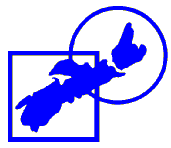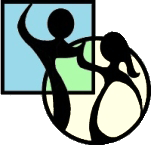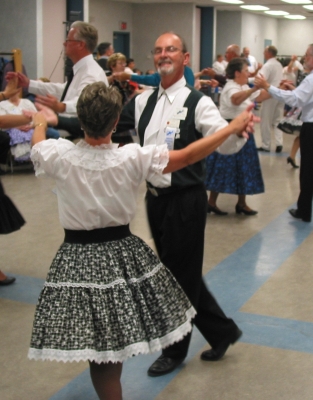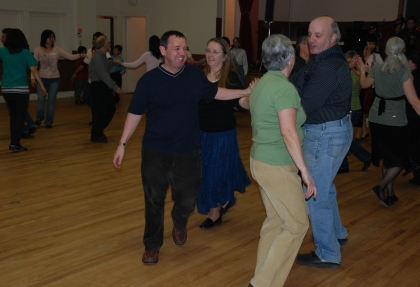

Square and Round Dance Federation
of Nova Scotia
Treat your Group to a Square or Round Dance Party
Are you searching for a different way to get members of your church or service organization together for a fun evening? Would your Girl Guide group like to provide fathers and daughters an opportunity to do something together? Want something that'll give an extra sparkle to your upcoming wedding reception? Callers and cuers are available to teach, call and cue for your special single-event dance, using any of the dance forms described below. Schedules are busy so please plan ahead. You can start by going to the Beginner Parties page.
Dance Forms in our World

Square Dancing organizes the dancers into groups of eight who form a square of 4 couples at the start of the dance. Traditional Square Dancing featured named dances that were set patterns often known to all of the local dancers. In its modern form the square dance choreography uses a vocabulary of calls known to the dancers. The caller "calls" these moves to create an endless variety of figures to keep the dancers entertained. Some figures are old favourites and some are spontaneous new creations. The music for Square Dancing ranges across many genres requiring only that it can be played at about 128 beats per minute. Expect to hear classic sing-a-longs, ragtime, jazz, big band, rock 'n' roll, folk songs, music from musicals and movies, country and western, disco, Latin, and what ever else might please the dancers.

Round Dancing organizes the dancers in couples facing counterclockwise around a big circle. It is basically pre-choreographed and cued ballroom dancing. Many choreographers have written superb choreography for specific pieces of music. This choreography is graded according to the number and difficulty of the moves used. Dancers learn the individual moves in a rhythm and phase (difficulty level) and with just a bit of practice are able to learn any dance that uses the set of moves, or with more experience are able to dance straight from the cues. Rhythms include waltz, two-step, polka, foxtrot, jive, rumba, cha-cha, tango and others. BACK

Contra Dancing usually organizes the dancers in facing lines. Dances are almost always walked through ahead of time. They typically consist of a 64-step figure that repeats, which helps less experienced participants smooth out their movements as the dance progresses. The music and choreography are more closely melded together than in Square Dancing, with clear emphasis on the 8-beat phrasing. Although modern music is sometimes used, many of the classic dances were choreographed for traditional jigs and reels. BACK